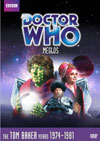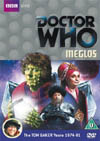DVD Extras include:
However the scripted plot, as it plays out, is not as fair toward the two points of view. The scientists are proven to be right, while the mystics act silly and only manage to hinder things as the plot goes along. It is chiefly Jacqueline Hill's strong acting, alongside the season's most innovative music scoring, that encourages the audience to continue to respect the mystics' and their culture. The mystic point of view contributes nothing to the resolution of the plot, and we end up with a more basic action story that is considerably less philosophically powerful than what the opening may have led us to anticipate at first. The TARDIS interior features quite heavily at the beginning of this story. As the camera pans across the console room during each loop of the chronic hysteresis, another John Nathan-Turner era upgrade shows itself - all the joins between the wall panels feature corrugated pillars. At last the console room feels perfect. Well done. The story also offers two satisfying materializations in later episodes, so the TARDIS is quite well represented in this one. The final dematerialization is more suggested than actually shown, by the dissolve between two completely different camera set-ups - not a good way to do things all the time, but you can get away with it once in a while. As with "The Leisure Hive", the Doctor doesn't actually get very involved in this one. Tom Baker himself is quite busy, but he spends half of his screen time playing the villain in this one, and the later episodes are extremely short to begin with. The middle episodes in particular seem to be really lacking in substance, but I think they get away with it more easily than "The Leisure Hive", because they do keep moving characters through environments they've never encountered before, which keeps the level of exploration and sci-fi discovery high, and makes for a good action plot. K9 seems quite artificially useless in the middle episodes; I just don't buy the lame excuse that his batteries have run down so quickly. After all, the Doctor and Romana have only just completed repairing him, and he's done next to nothing since setting off on this adventure. The Doctor doesn't fare much better on Tigella, simply showing up and getting accused. He never gets a chance to shine as an investigator, or to show any affinity for helping the Tigellans with their temperamental power source - which was the original purpose of his visit. What exactly was the reason for the power interruptions? The scripted story sadly ignores this later on. The final episode manages to make up for all this somewhat, by giving both the Doctor and K9 quite a bit of good stuff to do, and allowing the Doctor to finally confront his doppelganger. It is quite interesting to note how Baker portrays the two characters differently: Meglos is typically sour and resentful, with a reverence for power whether it comes from physics or political control. The Doctor, by contrast, is in jovial happy-go-lucky spirits for the most part, smiling as often as possible, and tackling his challenges with optimism and enthusiasm. This is a Doctor I thoroughly enjoy. It is interesting to note that the Doctor we saw in director Paddy Russell's stories like "Pyramids of Mars" (story no. 82) and "The Horror of Fang Rock" (story no. 92) more closely resembles Meglos than the Doctor of this adventure, another reason why I tend not to rate those adventures as highly as many others. General Grugger and Lieutenant Brotadac turn out to be a great pair of comedic villains in themselves - and the balance between humour and threats seems to be more carefully done and successful than was typically the case in previous seasons. I find Frederick Treves as Brotadac to be particularly enjoyable. But I think the guest star who shines brightest in this one is Jacqueline Hill. I can't say I cared much for her character Lexa when I first saw the story, but after having a chance to see Hill help shape the program in its first two years as Barbara Wright, it is wonderfully nostalgic to see her take on yet another strong female role and do it such wonderful justice, reminiscent of Barbara's imitation of the goddess Yetaxa in "The Aztecs" (story no. 6), but this time played with even more conviction. It is a great pity that Lexa has so little to do in the final episode, and what is given to her seems so artificially pasted onto the story. Such dismissal seems sadly typical of many sci-fi writers' narrow views of mysticism and religion at the time, trying to boil it all down to superstition and sacrifice. Most thankfully though, the Deons still prove far, far more interesting than all of the cookie-cutter cults that plagued the show from Hinchcliffe's era up to "The Stones of Blood" (story no. 100).
Unfortunately, we only get one shot of the thugs' spacecraft in flight when the story could easily have done with more, and this one shot is extremely lame - obviously flown by hands hidden behind the scenery. Indeed, the design of the craft itself seems to be more concerned with making something for which one can easily build a door in the studio, rather than in making something that looks like it could actually fly. Later episodes feature some laser effects - thankfully Dave Jervis took time to add visual beams in post-production. The sound for most of the laser fire turns out to be so wimpy, however, that part three's battle scene has considerably less dramatic power than it ought to. K9's blaster proves far more satisfying in the final episode.
International Titles:Deutsch: "Meglos"Magyar: "Meglos"Français: (Meglos)Русский: "Меглос"This story is available on DVD and VHS video:
Comments on this article are welcome. You may contact the author from this page:
|










